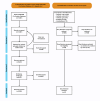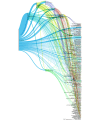Methods Used in Co-Creation Within the Health CASCADE Co-Creation Database and Gray Literature: Systematic Methods Overview
- PMID: 39527793
- PMCID: PMC11589503
- DOI: 10.2196/59772
Methods Used in Co-Creation Within the Health CASCADE Co-Creation Database and Gray Literature: Systematic Methods Overview
Abstract
Background: Co-creation is increasingly recognized for its potential to generate innovative solutions, particularly in addressing complex and wicked problems in public health. Despite this growing recognition, there are no standards or recommendations for method use in co-creation, leading to confusion and inconsistency. While some studies have examined specific methods, a comprehensive overview is lacking, limiting the collective understanding and ability to make informed decisions about the most appropriate methods for different contexts and research objectives.
Objective: This study aimed to systematically compile and analyze methods used in co-creation to enhance transparency and deepen understanding of how co-creation is practiced.
Methods: To enhance transparency and deepen understanding of how co-creation is practiced, this study systematically inventoried and analyzed methods used in co-creation. We conducted a systematic methods overview, applying 2 parallel processes: one within the peer-reviewed Health CASCADE Co-Creation Database and another within gray literature. An artificial intelligence-assisted recursive search strategy, coupled with a 2-step screening process, ensured that we captured relevant methods. We then extracted method names and conducted textual, comparative, and bibliometric analyses to assess the content, relationship between methods, fields of research, and the methodological underpinnings of the included sources.
Results: We examined a total of 2627 academic papers and gray literature sources, with the literature primarily drawn from health sciences, medical research, and health services research. The dominant methodologies identified were co-creation, co-design, coproduction, participatory research methodologies, and public and patient involvement. From these sources, we extracted and analyzed 956 co-creation methods, noting that only 10% (n=97) of the methods overlap between academic and gray literature. Notably, 91.3% (230/252) of the methods in academic literature co-occurred, often involving combinations of multiple qualitative methods. The most frequently used methods in academic literature included surveys, focus groups, photo voice, and group discussion, whereas gray literature highlighted methods such as world café, focus groups, role-playing, and persona.
Conclusions: This study presents the first systematic overview of co-creation methods, providing a clear understanding of the diverse methods currently in use. Our findings reveal a significant methodological gap between researchers and practitioners, offering insights into the relative prevalence and combinations of methods. By shedding light on these methods, this study helps bridge the gap and supports researchers in making informed decisions about which methods to apply in their work. Additionally, it offers a foundation for further investigation into method use in co-creation. This systematic investigation is a valuable resource for anyone engaging in co-creation or similar participatory methodologies, helping to navigate the diverse landscape of methods.
Keywords: CASCADE; co-creation; co-design; coproduction; inventory; methodology; methods; participatory; research methods; text mining.
©Danielle Marie Agnello, George Balaskas, Artur Steiner, Sebastien Chastin. Originally published in the Interactive Journal of Medical Research (https://www.i-jmr.org/), 11.11.2024.
Conflict of interest statement
Conflicts of Interest: None declared.
Figures







References
-
- Agnello DM, Loisel QEA, An Q, Balaskas G, Chrifou R, Dall P, de Boer J, Delfmann LR, Giné-Garriga M, Goh K, Longworth GR, Messiha K, McCaffrey L, Smith N, Steiner A, Vogelsang M, Chastin S. Establishing a health CASCADE-curated open-access database to consolidate knowledge about co-creation: novel artificial intelligence-assisted methodology based on systematic reviews. J Med Internet Res. 2023;25:e45059. doi: 10.2196/45059. https://www.jmir.org/2023//e45059/ v25i1e45059 - DOI - PMC - PubMed
-
- Darlington E, Masson J. What does co-creation mean? an attempt at definition informed by the perspectives of school health promoters in France. Health Educ J. 2021;80(6):746–758. doi: 10.1177/00178969211013570. - DOI
-
- van Woezik AFG, Braakman-Jansen LMA, Kulyk O, Siemons L, van Gemert-Pijnen JEWC. Tackling wicked problems in infection prevention and control: a guideline for co-creation with stakeholders. Antimicrob Resist Infect Control. 2016;5:20. doi: 10.1186/s13756-016-0119-2. https://aricjournal.biomedcentral.com/articles/10.1186/s13756-016-0119-2 119 - DOI - DOI - PMC - PubMed
-
- Greenhalgh T, Jackson C, Shaw S, Janamian T. Achieving research impact through co-creation in community-based health services: literature review and case study. Milbank Q. 2016;94(2):392–429. doi: 10.1111/1468-0009.12197. https://europepmc.org/abstract/MED/27265562 - DOI - PMC - PubMed
-
- Lewis CC, Taba M, Allen TB, Caldwell PH, Skinner SR, Kang M, Henderson H, Bray L, Borthwick M, Collin P, McCaffery K, Scott KM. Developing an educational resource aimed at improving adolescent digital health literacy: using co-design as research methodology. J Med Internet Res. 2024;26:e49453. doi: 10.2196/49453. https://www.jmir.org/2024//e49453/ v26i1e49453 - DOI - PMC - PubMed
Publication types
LinkOut - more resources
Full Text Sources
Miscellaneous

